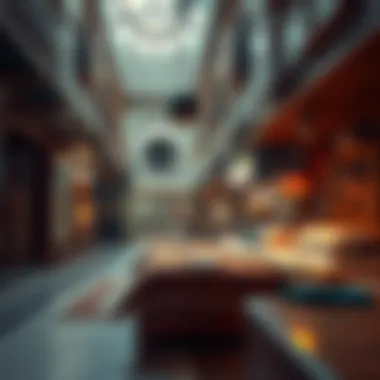Understanding Bed Space Dynamics in Bur Dubai's Meena Bazaar


Intro
Bur Dubai's Meena Bazaar pulsates with life, standing as a vibrant hub filled with rich culture and a tapestry of stories. The streets echo with the chatter of diverse communities, a perfect blend of local tradition and cosmopolitan flair. As the hustle of daily life unfolds, the demand for bed space within this melting pot presents both unique opportunities and challenges.
Understanding the dynamics of bed space in Meena Bazaar is crucial for various stakeholders, from prospective residents to real estate investors. With the area's booming commercial activities and proximity to essential amenities, people are increasingly drawn to this neighborhood. However, navigating the bed space market here requires insight into current trends, pricing shifts, and the socio-cultural underpinnings that make shared accommodations appealing.
This article embarks on a comprehensive exploration of the bed space scene in Meena Bazaar, unpacking the factors that shape its allure and addressing the concerns of those contemplating a move into this lively locale. Whether you are a long-time resident or a newcomer ready to dip your toes into the rental market, the information provided aims to enhance your understanding of this fascinating aspect of Bur Dubai.
Prelude to Bed Space in Bur Dubai
When it comes to finding affordable living options in bustling urban settings, bed space becomes a true talking point, especially in a place like Bur Dubai's Meena Bazaar. This area is known for its vibrant culture, but the increasing cost of living poses its own challenges. Bed space offers a viable solution, particularly for individuals and families navigating the housing market on a budget.
Defining Bed Space
Bed space refers to a shareable room or a designated sleeping area within a larger living space, often rented out to individuals seeking an economical alternative to full apartments or studios. This concept thrives in cities where rental prices can gouge the average person’s wallet. Each resident usually gets access to basic amenities, while sharing communal areas such as kitchens and bathrooms.
Typically, bed space is rented out on a monthly basis, catering primarily to expatriates, students, and single professionals. In Meena Bazaar, bed space can mean a shared room with two or three others, or a separated corner in a larger room with curtains for privacy. The advantage here is how it enables people to save on costs, extending their finances further while living in a prime, central location.
The arrangements can vary—the beds may be bunk beds in a lofted format or individual setups in flats. What’s common across the board is the community feel that develops among roommates, often leading to lasting friendships. Yet, it’s essential to understand that living in shared spaces comes with its own set of norms and responsibilities that residents must navigate.
Overview of Bur Dubai and Meena Bazaar
Bur Dubai is a historic district laden with charm, positioned strategically along the Dubai Creek. With its blend of traditional and modern influences, it has become one of the city’s most sought-after locales. The quarter boasts of eye-catching souks (markets), enchanting cultural spots, and a vibrant lifestyle that attracts both tourists and locals alike.
Meena Bazaar stands proudly within Bur Dubai, often recognized for its shopping experiences and diverse food options. Visitors and residents flock here not only to grab a good bargain but also to relish authentic culinary experiences from various cultures. The twists and turns of the bazaar bring a certain magnetism, making it one of the lively areas in the city. Yet, what really piques interest is the availability of bed spaces in this vibrant backdrop.
Living in Meena Bazaar means you are not just in close proximity to a slew of eateries and shops; you also gain access to various communal and recreational facilities. Schools, public transport, and medical facilities are very accessible, making it an attractive proposition for those looking to settle in and make the most out of urban living.
In this article, we'll explore the intricate details surrounding the bed space industry in Meena Bazaar, dissecting current demand and supply trends, potential financial implications, and what it's really like living in shared accommodations in this lively locale. Prospective residents, investors, and those interested in the real estate market should find ample insight into navigating this essential aspect of living in Bur Dubai.
The Bed Space Market in Meena Bazaar
The bed space market in Meena Bazaar stands as a vital component of the housing landscape in Bur Dubai. It offers a nuanced blend of affordability and convenience that attracts a diverse population, making it essential for investors, homeowners, and expatriates seeking adaptable living arrangements.
Understanding the dynamics of this market involves examining demand and supply factors, distinguishing it from other regions in Dubai, and grasping its appeal. The opportunities in this sector are numerous, but those looking to invest must be mindful of the existing competition and the unique elements that make Meena Bazaar distinct.
Current Demand Trends
Demand for bed space in Meena Bazaar has been on an upward trajectory. This upsurge can be attributed to several factors. Firstly, the area's central position, combined with its proximity to business hubs, has made it a favored spot among working professionals.
- Many of the residents come from countries like India, Pakistan, and Bangladesh, creating a tight-knit community where cultural connections flourish.
- Furthermore, the cost of living in Dubai can be daunting. Therefore, many residents find shared accommodations appealing, as they offer significant savings compared to traditional rental arrangements.
Another point to consider is the seasonal fluctuations in demand, particularly during holiday seasons when expatriates often return to their home countries. Additionally, the boom in the construction and hospitality industries has increased the influx of transient workers, further boosting demand.
Supply Dynamics
On the supply side, Meena Bazaar boasts a diverse array of options for potential tenants, ranging from basic accommodations to more upscale offerings. Supply influences come primarily from two sources:


- Existing Buildings: Many residential buildings in Meena Bazaar have been repurposed to cater to shared living arrangements, with owners keen to maximize occupancy.
- Developments: Recent projects tailored for this market have emerged, offering much-needed modern amenities, which are attractive to newcomers.
However, supply is not without its challenges. Some landlords may struggle with maintaining properties adequately, impacting the overall living experience. This disparity can create an uneven quality across different offerings, resulting in varied pricing structures.
Comparison with Other Areas in Dubai
When juxtaposed with other neighborhoods in Dubai, the Meena Bazaar bed space market presents its distinct flavor. Compared to areas like Dubai Marina or Jumeirah, where high-end properties dominate, Meena Bazaar caters more to the budget-conscious.
- Affordability: The average rent in Meena Bazaar is comparatively lower, making it an attractive alternative for young professionals and expatriates.
- Cultural Appeal: The vibrant street life, complete with various food stalls and retail outlets, lends a unique atmosphere not easily replicated in more upscale areas.
- Ease of Connectivity: Well-established transport links enhance the area’s appeal, ensuring residents can easily navigate to workplaces.
In essence, while other neighborhoods might offer a more luxurious living situation, Meena Bazaar provides an accessible and culturally rich communal experience that continues to attract a steady stream of residents.
Financial Considerations
Understanding the financial landscape of bed space in Bur Dubai is crucial for anyone eyeing a residence in this bustling area. Financial considerations not only dictate the practicality of living arrangements but also influence the long-term sustainability of investments in the local property market. Prospective tenants and investors alike must navigate the intricacies of rental costs and additional expenses to make informed decisions. Being well-acquainted with these elements can facilitate the selection of the right accommodation while optimizing financial commitments.
Average Rental Costs
The rental costs of bed space in Meena Bazaar vary significantly depending on a few key factors, including location, amenities, and the condition of the property. On average, a bed space in shared accommodations can range from 1,200 to 2,500 AED per month. Typically, basic facilities in older buildings may feature lower rental prices, whereas newly constructed properties or those located closer to amenities command higher rents. For instance, flats that offer utilities included in the rent might seem appealing, but a quick comparison with properties that have separate utility bills could save residents a fair bit over time.
It's essential to also factor in potential fluctuations in rental pricing due to peak tourist seasons or local events. The demand can substantially rise during festivals or holidays, leading to increased rates that might not have been apparent during the quieter months. Thus, being strategic about timing when searching for bed space is highly beneficial.
Moreover, understanding the variety in pricing depending on the number of occupants per unit reveals a lot. If a room accommodates four people instead of two, the overall cost distribution tends to be more economical. This can help to sift through what options best fit various financial capacities.
Additional Expenses for Residents
While the rent is often the most visible of the financial considerations, additional expenses can quickly add up, impacting one's budget. Common supplementary costs may include:
- Utilities: Unlike houses or larger apartments where utilities might be bundled into the rent, in bed spaces, residents often split utilities among themselves. Water and electricity bills can vary, but a good rule of thumb is to expect an additional 100 to 300 AED monthly, per individual.
- Internet: Many shared accommodations may not provide free internet. If it is available, sharing costs often becomes a necessity. Residents may anticipate allocating around 100 to 150 AED monthly for a reliable connection, especially if working remotely or streaming services are typical activities.
- Grocery and Household Supplies: Shared living means shared responsibilities, yet individual grocery expenses may fluctuate based on personal consumption habits. Averages might range from 300 to 600 AED a month. Joint purchasing can alleviate some burden, fostering a sense of community among housemates.
- Transportation: Factor in the daily commute; being aware of public transport costs or parking fees, if driving, is important. Budgeting around 200 to 400 AED for this might be wise, depending on distance and travel frequency.
Living Conditions in Bed Space
The reality of living in bed space arrangements in Bur Dubai, particularly around Meena Bazaar, is as much about community as it is about convenience. Understanding these living conditions is crucial for both potential residents and investors. One must consider not only the monetary aspects but the quality of life afforded in these shared setups. Bed space accommodations offer unique advantages and challenges that shape the everyday experiences of their residents.
Amenities Typically Offered
When you choose to reside in a bed space situation, you can typically expect to find a bundle of shared amenities. These can differ from one establishment to another, but some of the more common offerings include:
- Shared Kitchens: These are fitted with essential appliances like refrigerators, stovetops, and microwaves. Often, individual residents are expected to maintain cleanliness.
- Laundry Facilities: Many places provide washing machines, allowing residents to wash their clothes without needing to go to laundromats.
- Common Areas: Living rooms or lounge spaces often serve as social hubs where residents can relax or entertain guests.
- Wi-Fi Access: In today's digital age, high-speed internet is a must. Most bed space setups provide this as part of the package.
Costs vary depending on the configuration of these amenities, and they can substantially affect the livability of the space, creting a strong sense of shared community.
Health and Safety Regulations
In terms of health and safety, regulations must be adhered to, which is crucial for residents’ well-being. Regulatory frameworks ensure that the living conditions are up to standard. Key points include:
- Regular Inspections: Authorities frequently inspect the buildings to ensure they comply with safety codes.
- Fire Safety Measures: Shared spaces must have appropriate fire safety equipment, including extinguishers and smoke detectors.
- Hygiene Standards: Landlords should maintain regular cleaning schedules in common areas. This helps combat the spread of illnesses, especially in settings where individuals share spaces.


Residents should familiarize themselves with these regulations to ensure a safer living environment.
Cultural Aspects of Shared Living
Living in bed space is not merely about sharing physical space; it’s also about navigating diverse cultures. Meena Bazaar is a vibrant tapestry of ethnicities, where it’s common to encounter:
- Multicultural Interactions: Expats and locals from various backgrounds come together, making for a lively exchange of ideas and traditions. This mingling offers residents a chance to learn from each other, leading to enriching experiences.
- Shared Festivals and Traditions: Many residents bring their culture into shared spaces. Celebrating different festivals fosters friendships and builds community bonds, creating a homey atmosphere despite the shared living conditions.
- Support Networks: For many expatriates, shared living becomes a support system where they can rely on one another in a foreign environment. This is particularly beneficial for newcomers who may feel lost in a new country.
In essence, the cultural dynamics within bed spaces add a layer of complexity to living arrangements, further enhancing the experience for residents.
Demographics of Bed Space Residents
Understanding the demographics of bed space residents in Bur Dubai's Meena Bazaar is pivotal for a myriad of reasons. As this area attracts a mix of individuals, from expatriates seeking short-term living arrangements to locals looking for affordable housing, recognizing the profiles of these residents can illuminate trends in demand, pricing strategies, and even local market dynamics. Furthermore, it paints a picture of the vibrant multicultural atmosphere of Meena Bazaar, emphasizing how shared living arrangements cater to diverse groups.
Profiles of Typical Residents
The residents of bed spaces in Meena Bazaar often include a blend of young professionals, students, and families. Here are some typical profiles:
- Young Professionals: Many expats fall into this category. They usually seek cost-effective living options as they establish their careers in the bustling labor market of Dubai. These individuals tend to share spaces due to the high cost of living, preferring locations like Meena Bazaar for its accessibility to transport and amenities.
- Students: With a host of universities nearby, students comprise a significant part of the demographic. They favor bed spaces for their affordability and proximity to educational institutions, allowing them to focus on study rather than financial strains.
- Local Workers: Many local workers, involved in various trades and service sectors, also opt for bed space arrangements. They appreciate the community aspect that shared living provides, fostering connections with others in similar socioeconomic brackets.
"The shared living experience not only reduces costs but also builds a sense of community, especially for those new to the area."
Each profile contributes distinctively to the community. Young professionals often bring a dynamic and energetic ethos, while students infuse freshness and diversity. On the other hand, local workers tend to emphasize stability and longevity in the neighborhood.
Expats and Local Population Dynamics
Meena Bazaar epitomizes a melting pot, showcasing the interplay between expatriates and locals. The expatriate population, predominantly from South Asia, thrives here, constituting a considerable percentage of bed space residents.
- Expatriate Influence: The influx of expatriates has led to a noticeable demand for affordable shared living spaces. This demographic often comes to Dubai for job opportunities and is typically drawn to the Meena Bazaar due to its vibrant cultural scene. They bank on the advantages of shared living where costs are significantly lower than privately leased accommodations.
- Community Integration: While expatriates are prevalent, the local population also plays a crucial role in shaping the demographics of the area. Their presence lends authenticity and depth to the neighborhood. The blending of cultures results in a unique living experience, where traditional Emirati values meet contemporary global influences.
- Economic Contributions: Together, expats and locals contribute to the economic fabric of Bur Dubai. The shared spaces not only serve as residences but enhance local commerce, as many residents shop and dine in the nearby markets, further increasing economic interdependence.
In summary, the demographics of bed space residents in Bur Dubai’s Meena Bazaar provide invaluable insights into the socio-economic frameworks governing the area. Understanding these dynamics aids in grasping the trends that shape both the housing market and community interactions.
Legal Framework Governing Bed Space
Understanding the legal framework surrounding bed space in Bur Dubai, especially in the bustling Meena Bazaar area, is crucial for both tenants and landlords. The legal stipulations set out rights, responsibilities, and protections that contribute to a stable living situation. For expats and residents, comprehending these regulations not only promotes security but also enhances the overall quality of life. Conversely, for landlords, adherence to these laws is essential in maintaining their investments and managing properties wisely.
Regulations Affecting Tenants
Tenants in Bur Dubai's Meena Bazaar must be aware of several key regulations that govern their rights. Some of the primary aspects include:
- Rental Contracts: All bed space arrangements must be documented in a formal rental contract. This should clearly outline the terms of the tenancy, including duration, payment schedules, and any rules about shared living. This written agreement is what secures the tenant’s rights.
- Tenancy Law: Dubai’s rental law stipulates that tenants can’t be unfairly evicted and outlines the procedures landlords must follow. It’s important for residents to know their rights regarding notice periods and legal grounds for eviction.
- Deposit Regulations: Typically, landlords require a security deposit, the return of which must adhere to the conditions laid out in the rental agreement. Understanding how deposits are handled can help prevent future disputes.
These regulations serve not just as a list of do's and don’ts for tenants but act as a safety net in the bustling real estate environment of Bur Dubai.
"Understanding your rights as a tenant can prevent a multitude of misunderstandings and disputes in your shared living situation."
Landlord Responsibilities


On the flip side, landlords have specific responsibilities that must be upheld to ensure lawful and fair housing. These responsibilities include:
- Maintenance Obligations: Landlords are required to keep the property in good repair. This includes addressing issues like plumbing, electrical problems, and other essential amenities that make the living space habitable. Failing to do so can lead to tenant disputes and potential legal issues.
- Compliance with Health Codes: The properties must adhere to health and safety regulations. This can encompass everything from ensuring the facility has proper sanitation measures in places, such as clean communal kitchens and bathrooms, to maintaining fire safety protocols.
- Transparency in Communication: Being forthright about rental terms, changes in property management, or upgrades is crucial. Open lines of communication can create trust and prevent misunderstandings that could escalate into legal disputes.
In a community as diverse as Meena Bazaar, where individuals from various backgrounds cohabitate, understanding these responsibilities helps create an environment of respect and shared accountability.
For further information on tenant rights and landlord responsibilities in Dubai, you can visit Dubai Land Department or Dubai Rental Tribunal.
Through reinforcing these legal frameworks, both landlords and tenants can contribute to a harmonious living situation while safeguarding their interests.
Future of Bed Space in Bur Dubai
The future of bed space in Bur Dubai, particularly in the vibrant Meena Bazaar area, plays a significant role in shaping the local housing landscape. This discussion encompasses a variety of elements that are essential for both current residents and potential investors. Understanding these factors allows stakeholders to navigate the complexities of living arrangements and capitalize on emerging opportunities.
As urbanization progresses, the demand for affordable housing solutions in Bur Dubai is likely to rise. Bed space accommodations cater to individuals seeking budget-friendly options without falling short on accessibility to key amenities. This situation creates a fertile ground for landlords and property developers to explore innovative solutions, ensuring they keep up with the evolving needs of residents.
"Urban development is not just about buildings; it's about creating a cohesive living environment that nurtures community and accessibility."
Impacts of Urban Development
Urban development significantly influences the prospects for bed space in Meena Bazaar. With ongoing developments such as improved public transport and the establishment of new commercial hubs, the attractiveness of this area continues to grow. Projects like the Dubai Metro expansion enhance connectivity, thereby increasing the desirability of living in Bur Dubai.
Moreover, with rising real estate investments and infrastructural upgrades, the neighborhood is transforming into a nexus for both expatriates and locals. As new establishments sprout up, the demand for bed space is set to surge, potentially leading to a supply shortage in the coming years.
Key factors to consider include:
- Increased foot traffic: The urban renewal projects draw more visitors and residents, boosting local businesses and services.
- Rising property values: As demand increases, property prices may escalate, which can trickle down to bed space rentals.
- Enhanced quality of life: New amenities and public spaces can improve the living experience, attracting more young professionals.
Trends to Watch in the Housing Market
Several trends are poised to influence the housing market in Bur Dubai, particularly concerning bed space offerings:
- Shift Toward Co-living Spaces: As attitudes toward communal living evolve, more developers are likely to create spaces that emphasize social interaction and shared resources. This approach not only reduces living costs but also fosters a sense of community.
- Sustainability and Eco-friendliness: With growing awareness around environmental issues, potential tenants are now more inclined to seek out energy-efficient and environmentally friendly housing options. Providers who adapt will stand to benefit from this shift.
- Technological Integration: The rise of smart home technology and property management systems can further streamline operations, enhancing the living experience for residents. This can lead to a more tailored and responsive housing market, meeting the demands of contemporary lifestyle preferences.
By closely monitoring these trends, investors and homeowners can make informed decisions regarding buying or renting in Bur Dubai. The bed space dynamic is evolving, and being attune to these indicators will facilitate proactive strategies in navigating the market's future.
Culmination
The exploration of bed space in Bur Dubai's Meena Bazaar has illuminated several crucial aspects of the housing environment in this bustling area. Understanding the dynamics of bed space availability is not merely an academic exercise but holds practical significance for potential residents, investors, and other stakeholders. The highlights of this article underscore that this form of housing offers affordability and accessibility in a rapidly urbanizing context.
Summary of Key Insights
In examining the bed space market, several key insights emerge:
- Current Demand Trends: Demand for bed space in Meena Bazaar reflects the influx of expatriates and young professionals seeking economical living solutions.
- Cost Considerations: While average rental costs are comparatively lower, additional expenses such as utilities and maintenance can add to the financial burden.
- Cultural Aspects of Shared Living: The vibrant, multicultural environment fosters a sense of community among residents, but it also necessitates an understanding of communal living dynamics.
These elements weave together to form a nuanced picture of what living in this area entails.
Final Thoughts on Living in Bur Dubai's Meena Bazaar
Living in Bur Dubai's Meena Bazaar provides a unique opportunity for those who value cultural experiences and economic livability. It's a place where the old meets the new, and the bustling souks sit harmoniously alongside modern conveniences. However, prospective residents should be mindful of the nuances that come with shared living arrangements. Communication and mutual respect play pivotal roles in navigating this shared space.
Aligning your expectations with the realities of living in a vibrant neighborhood such as Meena Bazaar can lead to a fulfilling experience. As urban development progresses, keeping an eye on future trends can provide insights into housing opportunities that arise.







